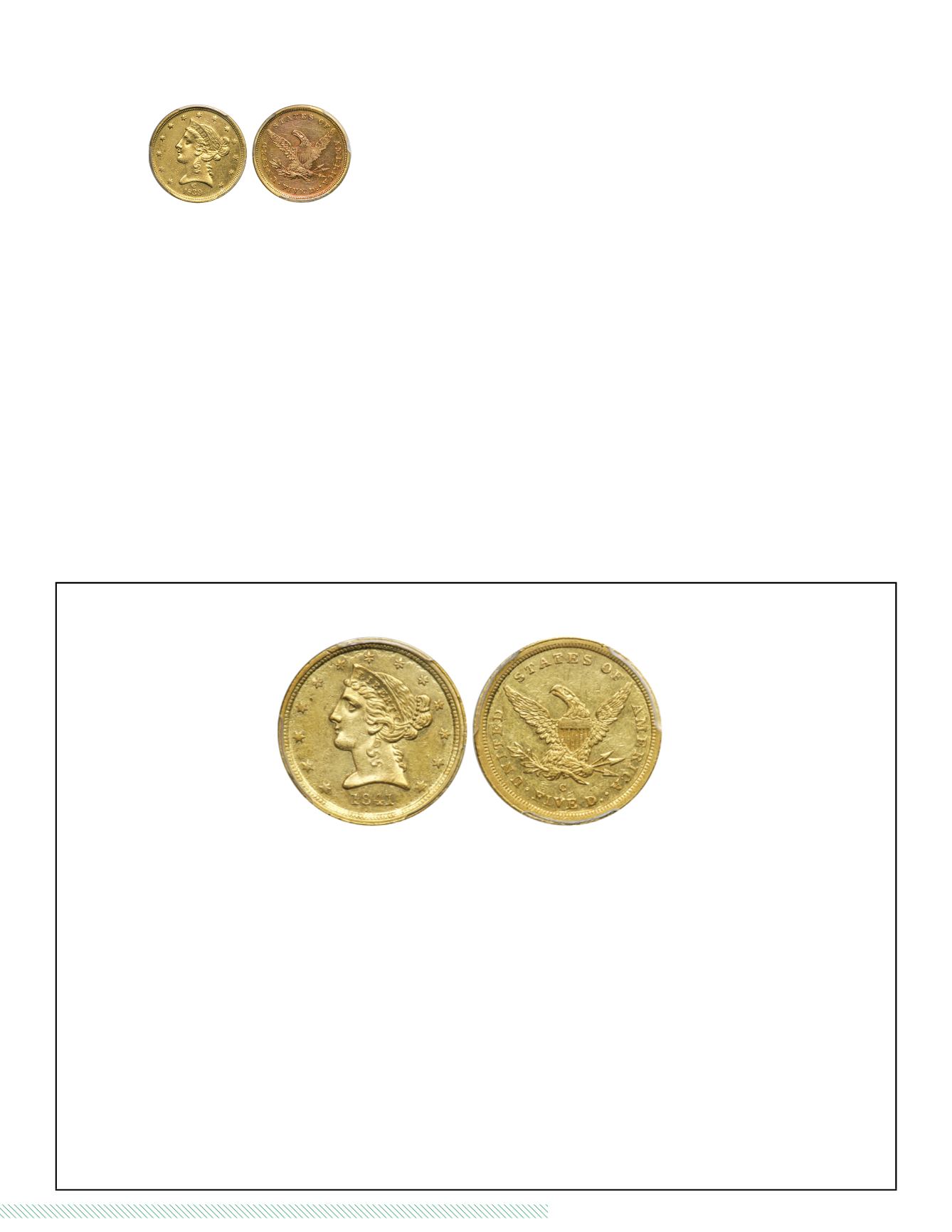
1
271
bid online at
(800) 978-COIN (2646)
|
Session Four - Tuesday, June 3, 2014 6:00 PM
$5 Li be r t y /No Mo t t o
1804
1839-C. PCGS graded Genuine, Filed Rims - AU Details
.
Light gold obverse toning while the reverse shows lovely red
and golden toning. Only 17,205 struck. The details on the
obverse relief features are boldly struck save for some flat stars,
and more than you see with most of the surviving 1839-C half
eagles. The reverse stands slightly below this inasmuch as the
right side of the eagle from shield down to claw failed to com-
pletely strike. All this same, the leaves the viewer wide-
mouthed and in awe at the remarkable sharpness found on Lib-
erty's hair and hair bun for such an early Charlotte branch mint
gold coin.
Among the earlier dates none are more popular than those
struck at the Dahlonega and Charlotte mints, in this era the
metal used was being supplied from the regional hills and val-
leys (interestingly, during the 1850s much gold from California
was shipped to these two mints, changing the scenario). In the
first year, 1839, the mintmarks were placed on the obverse. The
idea lasted but a short time, and beginning in 1840 the reverse
was used, the same being true in the silver half dollar series.
(
PCGS # 8192
)
Estimated Value ..............................................$1,500 - 1,600
M
INT
S
TATE
1841-C $5 L
IBERTY
Enlargement
1805
1841-C
.
PCGS graded MS-61
. Frosty. Only 21,467 struck. Well struck at main devices with some unusual roughness and lack of detail
around the wide borders which have partial wire rims. Plenty of satiny mint luster, however, remains and all is lightly golden colored. Indeed,
the strike on this early C-mint rarity is all that could be desired: full hair waves (including the long curl above the ear which is exquisitely
detailed, clear hair bun and beaded cord. And equally impressive eagle where the neck and leg feathers show complete definition, as does the
shield. The leaves show their central veins; the arrowheads, their shafts. Bold square rims act like a picture frame around the entire composi-
tion. A substantial number of light handling abrasions on the reverse. Gold coins, when stored in bank vaults to back paper money circulation,
were often stored in bags or chests and moved around a great deal. See anecdote which follows. A worthwhile bid is called for to obtain this
handsome specimen.
Pop 4; 3 finer, 1 in 62, 2 in 62+
. (
PCGS # 8203
)
Humorous Anecdote: Andrew Dickson White, the founder of Cornell University, writes in his 19th century autobiography that when he was a
young man he would sometimes accompany a bank examiner on his regular auditing rounds into the rural districts of Michigan. They had a
regular game they played between the circuit rider on horseback (the bank auditor) and the often times shady bankers who were in cahoots
with each other. It was well known that when word got out in a district that the examiner had just done the books and checked the gold
reserves of a bank, a messenger on fast horseback would be sent forth with the same bag of gold coins that had just been audited, and race
ahead of the examiner to the next bank up the line. (That bank would often be owned by the same individual.) When the bank examiner
finally arrived a day or two later at the second bank to do its accounts, he’d find everything proper, the books balanced and the gold reserve
adequate. The examiners knew they were being hoodwinked, that they were viewing the same gold coins over and over again. They were no
fools. Everyone played at the charade. And that was how the game operated in the days of Wildcat Banking in the 1840s and 1850s! (Perhaps
this heavy handling and constant movement explains some of the surface marks and abrasions on otherwise obviously Mint State gold coins
of the 19th century.).
Estimated Value ........................................................................................................................................................... $14,000 - 15,000


